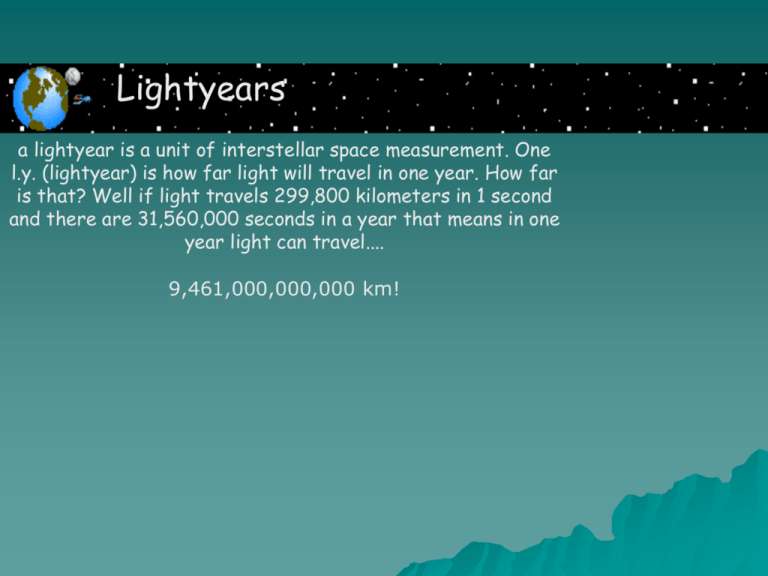light year
advertisement

Lightyears a lightyear is a unit of interstellar space measurement. One l.y. (lightyear) is how far light will travel in one year. How far is that? Well if light travels 299,800 kilometers in 1 second and there are 31,560,000 seconds in a year that means in one year light can travel.... 9,461,000,000,000 km! A light year is a way of measuring distance. That doesn't make much sense because "light year" contains the word "year," which is normally a unit of time. Even so, light years measure distance. Cool Fact A light nanosecond -- the distance light can travel in a billionth of a second -- is about 1 foot (about 30 cm). Radar uses this fact to measure how far away something like an airplane is. A radar antenna sends out a short radio pulse and then waits for it to echo off an airplane or other target. While it's waiting, it counts the number of nanoseconds that pass. Radio waves travel at the speed of light, so the number of nanoseconds divided by 2 tells the radar unit how far away the object is! http://science.howstuffworks.com/question94.htm Using a light year as a distance measurement has another advantage -- it helps you determine age. Let's say that a star is 1 million light years away. The light from that star has traveled at the speed of light to reach us. Therefore, it has taken the star's light 1 million years to get here, and the light we are seeing was created 1 million years ago. So the star we are seeing is really how the star looked a million years ago, not how it looks today.. In the same way, our sun is 8 or so light minutes away. If the sun were to suddenly explode right now, we wouldn't know about it for eight minutes because that is how long it would take for the light of the explosion to get here Why would you want such a big unit of distance? Well, on Earth, a kilometer may be just fine. It is a few hundred kilometers from New York City to Washington, DC; it is a few thousand kilometers from California to Maine. http://starchild.gsfc.nasa.gov/docs/StarChild/questions/question19.html In the Universe, the kilometer is just too small to be useful. For example, the distance to the next nearest big galaxy, the Andromeda Galaxy, is 21 quintillion km. That's21,000,000,000, 000,000,000 km. This is a number so large that it becomes hard to write and hard to interpret. So astronomers use other units of distance. In our solar system, we tend to describe distances in terms of the Astronomical Unit (AU). The AU is defined as the average distance between the Earth and the Sun. It is approximately 150 million km (93 million miles). Mercury can be said to be about 1/3 of an AU from the Sun and Pluto averages about 40 AU from the Sun. The AU, however, is not big enough of a unit when we start talking about distances to objects outside our solar system. http://starchild.gsfc.nasa.gov/docs/StarChild/questions/question19.html For distances to other parts of the Milky Way Galaxy (or even further), astronomers use units of the light-year or the parsec . 1 parsec (pc) = distance d when angle is 1 arcsecond = 3.086 1013 km = 3.26 ly http://starchild.gsfc.nasa.gov/docs/StarChild/questions/question19.html http://starchild.gsfc.nasa.gov/docs/StarChild/questions/question19.html The Andromeda Galaxy is 2.3 million light-years away. http://starchild.gsfc.nasa.gov/docs/StarChild/questions/question19.html The Milky Way Galaxy is about 150,000 light-years across http://starchild.gsfc.nasa.gov/docs/StarChild/questions/question19.html The Crab supernova remnant is about 4,000 light-years away. http://starchild.gsfc.nasa.gov/docs/StarChild/questions/question19.html Stellar parallax Parallax is the apparent displacement of a foreground object relative to the background as the observer’s location changes. The closer the object is the greater the parallax so small parallax implies large distance, large parallax implies small distances We can convert baselines and parallaxes into distances. To compute the planet’s distance; Distance = baseline x (360o/2p)/parallax 360o/ 2p = 57.3o or 1 radian Parallax is the angle between two points of the baseline However at extreme distances the angle of Parallax becomes infinitesimally small and hence unusable. Angular Diameter: By measuring the object’s angular diameter, we can compute its size. Diameter = distance x angular diameter/57.3O Example – The moon’s angular diameter is measured to about 31 arc minutes – a little over half a degree. By putting this into the equation we get a diameter of about 3450km. Angles Astronomy involves thinking about angles--often very tiny, tiny angles. A circle is divided into 360 degrees (or 360°). Each degree is divided into 60 arcminutes (or 60'). Each arcminute can be divided into 60 arcseconds (or 60"). Therefore there are 360x60x60 = 1,296,000 ~ 1.3 x 106 arcminutes in a full circle. Distances in the sky are measured in degrees. The degrees are originally taken from the degrees around a circle. It is easy for star watchers to measure degrees with their hands. To use your hand as a measuring tool, you need to hold your hand in front of you at an arm's length. http://www.physast.uga.edu/~jss/1010/ch2/ovhd.html Since we know the Earth has to rotate completely in 24 hours, and one entire rotation means circling 360°, the rate in degrees that the Earth rotates per hour is: 360 degrees 15 degrees Rotation rate = ------------- = -----------24 hour hour Or 15° per hour







